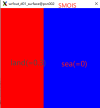Hi, WRF support:
The fact that SMOIS and TSLB in the wrfout became 0 over the ocean after I added some land in an ideal experiment seems unreasonable to me. Could you please explain the reason for this? Attached is a figure.
The second question: I would like to know the most effective way to modify surface roughness and soil moisture in an ideal test. My current approach is to change the underlying surface vegetation type without modifying Z0. Is this approach correct?
The fact that SMOIS and TSLB in the wrfout became 0 over the ocean after I added some land in an ideal experiment seems unreasonable to me. Could you please explain the reason for this? Attached is a figure.
The second question: I would like to know the most effective way to modify surface roughness and soil moisture in an ideal test. My current approach is to change the underlying surface vegetation type without modifying Z0. Is this approach correct?

